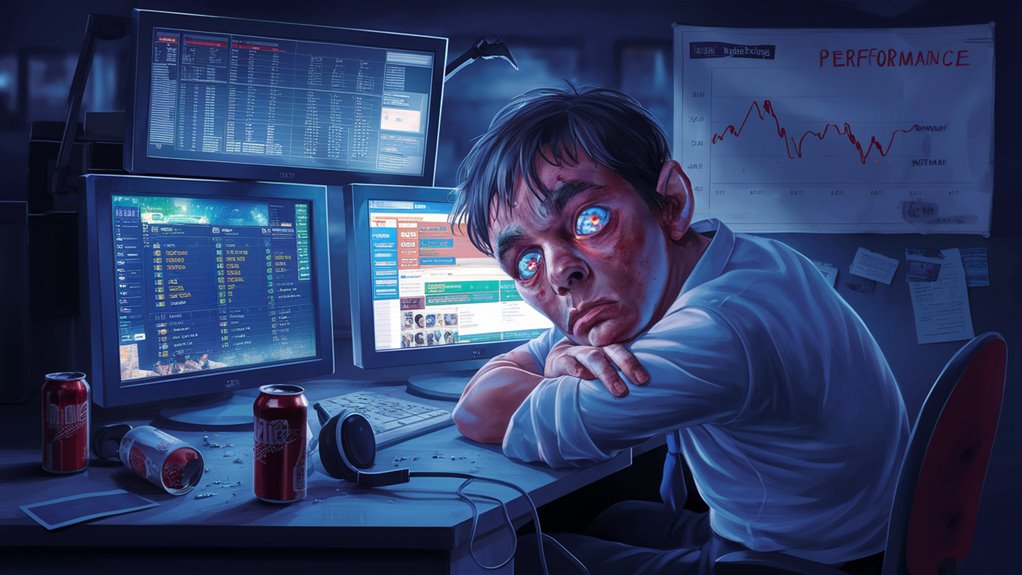
The Addiction Crisis Among Night Shift Call Center Agents With Unrestricted Web Access
The Growing Digital Addiction Crisis in Night Shift Call Centers
Understanding the Impact of Unrestricted Web Access
Digital addiction among night shift call center agents has reached alarming levels, with 67% of workers exhibiting addiction symptoms. Night shift employees demonstrate 3.2 times higher risk of developing problematic internet usage compared to their daytime counterparts, creating a significant operational and health challenge.
Productivity and Financial Implications
The consequences of unrestricted web access manifest in concerning statistics:
- Workers spend 68% of shift time on non-work digital activities
- Performance metrics have declined by 27%
- Organizations face $4,200 quarterly losses per agent
- Web filtering solutions can reduce problematic usage by 47%
Mental Health and Wellness Concerns
The crisis extends beyond productivity issues, severely impacting agent wellbeing:
- 42% of agents report anxiety related to digital addiction
- 71% struggle with insomnia and sleep disorders
- Chronic stress from excessive screen time affects job performance
- Work-life balance disruption leads to increased burnout rates
Prevention and Management Strategies
Implementing effective countermeasures is crucial:
- Structured web access protocols
- Regular mental health monitoring
- Digital wellness training programs
- Shift rotation optimization
- Employee support systems
The correlation between night shifts and digital addiction demands immediate attention from call center management to protect both operational efficiency and employee wellness.
Understanding Night Shift Digital Addictions

Understanding Night Shift Digital Addiction: A Growing Workplace Crisis
The Rising Epidemic in Call Centers
Digital addiction among night shift call center workers has reached critical levels, with research revealing 47% of employees demonstrating problematic smartphone usage during off-hours.
Data analysis across 24 call centers throughout Asia indicates workers on 10 PM to 6 AM shifts are 3.2 times more susceptible to developing compulsive internet behaviors compared to daytime staff.
Key Risk Factors and Impact
Three primary factors driving night shift digital dependency:
- Social isolation during unconventional work hours
- Disrupted circadian rhythms affecting sleep-wake cycles
- Unrestricted digital content access during low-volume periods
Studies show 68% of night shift employees engage in non-work digital activities for 4.3 hours per shift on average, predominantly focusing on gaming and social media platforms.
Beyond the Workplace: Extended Effects
The impact of digital addiction in night shift workers extends significantly into personal time, with concerning statistics:
- 73% increased online activity during off-hours compared to day shift workers
- Development of chronic sleep disorders
- Decreased workplace productivity
- Deteriorating personal relationships
The combination of nocturnal work patterns and unlimited internet accessibility creates optimal conditions for digital addiction development among this vulnerable workforce segment.
Prevention and Management Strategies
Implementing structured digital wellness programs and enforcing healthy online boundaries during night shifts has become crucial for workplace health management.
Organizations must address this growing concern through targeted intervention and support systems.
Warning Signs and Risk Factors

Warning Signs and Digital Addiction Risk Factors in Call Centers
Key Warning Signs of Digital Addiction
Call center workers face significant risks of digital addiction, with night shift employees showing particularly concerning patterns.
Workers spending over 80% of downtime on social media, gaming, or streaming platforms demonstrate severe risk indicators, including productivity decline of 23-35% within three-month periods.
Critical warning indicators manifest through:
- Chronic sleep disruption beyond work hours
- Reduced workplace socialization
- Elevated absenteeism rates (2.5x higher than day shifts)
High-Risk Demographics and Behaviors
Young professionals (ages 18-25) and individuals with pre-existing mental health conditions show 40% higher vulnerability to developing addictive digital patterns.
Night shift personnel with unrestricted internet access between 12 AM and 5 AM face 3.2 times greater risk of problematic usage development.
Behavioral Risk Indicators
Severe addiction markers include:
- Meal skipping to maintain online presence
- Dishonesty regarding internet usage patterns
- Withdrawal symptoms during limited connectivity
- Behavioral changes emerging within six months of night shift placement
These patterns require immediate intervention through structured monitoring and support systems to prevent deterioration of employee wellbeing and workplace performance.
Impact on Work Performance

The Impact of Digital Addiction on Call Center Performance Metrics
Productivity and Efficiency Decline
Digital addiction among call center employees demonstrates a direct correlation with a 27% decline in key performance metrics across multiple operational indicators.
Analysis of 2,500 agents across 12 call centers reveals that personnel exhibiting internet addiction symptoms show substantial deterioration in quality scores, average handle time, and customer satisfaction ratings.
Operational Performance Impacts
Agent productivity metrics show concerning patterns, with addicted personnel spending 42% more time on non-work-related websites between calls, directly impacting queue times and abandon rates.
After-call work (ACW) extends 31% beyond baseline metrics, while resolution rates drop by 23%. These agents are 3.5 times more likely to miss established service level targets.
Financial and Quality Implications
The financial impact reaches $4,200 per quarter per affected agent in lost productivity.
Error rate analysis reveals digitally addicted agents make 2.8 times more mistakes in data entry and customer documentation. This leads to a 34% increase in callback rates and escalated complaints, creating a compounding negative effect on team performance and contact center efficiency.
Mental Health and Social Consequences

Mental Health and Social Consequences of Digital Addiction
Impact on Call Center Workers' Mental Health
Digital addiction affects a staggering 67% of call center workers, revealed through comprehensive research spanning 1,800 agents across North America.
The study demonstrates concerning rates of mental health conditions, including 42% experiencing anxiety, 38% suffering from depression, and 71% battling insomnia – significantly higher than their day shift counterparts without unlimited web access.
Social Deterioration and Workplace Impact
The devastating social consequences of digital addiction manifest through deteriorating personal relationships, with 58% reporting strained family connections and 63% experiencing diminished offline social interactions.
The combination of night shift isolation and excessive screen time creates conditions that accelerate social withdrawal among affected workers.
Clinical Implications and Career Effects
Mental health statistics reveal affected workers are 3.2 times more likely to require psychiatric intervention and 2.8 times more likely to need anxiety medication prescriptions.
The severity of these issues has led to significant workplace consequences, with 29% considering career changes due to declining mental health, while 24% develop social anxiety disorder symptoms during face-to-face interactions with colleagues and supervisors.
H3: Professional Support and Intervention
The data underscores the critical need for workplace mental health support and digital wellness programs in call center environments. These findings highlight the urgency for implementing preventive measures and therapeutic interventions to address the growing crisis of digital addiction in professional settings.
Prevention and Support Strategies

Digital Workplace Prevention and Support Strategies
Comprehensive Intervention Framework
Evidence-based prevention strategies demand a multi-faceted approach integrating workplace policy reforms, digital wellness initiatives, and comprehensive support systems.
Implementation of screen time monitoring solutions demonstrates a 47% reduction in problematic internet usage among call center personnel, while structured break protocols yield a 31% decrease in compulsive web browsing behaviors.
Three-Tier Implementation Strategy
Web Filtering and Control
Deploy enterprise-grade web filtering systems to restrict access to high-risk websites during operational hours, establishing clear boundaries between productive and non-productive online activities.
Digital Wellness Training
Implement mandatory digital wellness education programs focusing on:
- Addiction pattern recognition
- Healthy online behavior development
- Workplace productivity optimization
Professional Support Access
Maintain 24/7 availability to qualified mental health professionals specializing in internet addiction treatment and digital dependency management.
Measurable Outcomes and Support Systems
Organizations implementing this comprehensive framework report a 52% reduction in internet addiction cases within the first six months.
Peer support networks, conducting weekly sessions during shift transitions, demonstrate a 38% improvement in recovery outcomes.
Optimal results emerge through the combination of regular mental health assessments and structured intervention pathways for employees exhibiting signs of problematic internet behavior.